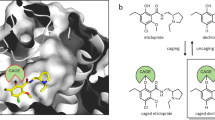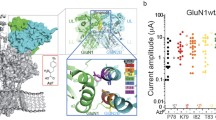Abstract
The synthesis of a new type of antagonist is described, capable of inactivating neuroreceptors with heretofore unattainable selectivity and permanence. These antagonists are referred to as mazek agonists (i.e. direct, inhibitory agonists) as they have the high receptor affinity and initial receptor-stimulatory effect of direct agonists and are positively coupled to effector systems. However, like direct antagonists, they have a high receptor affinity and the potential to inhibit or prevent receptor stimulation. The synthesis of the present compounds consisted of the covalent attachment of a tethered dye to three different neurotransmitter analogues, resulting in dye-neuropeptide conjugates with a high affinity for the FMRFa receptor. The dye was prepared from azure B (Az), the neurotransmitter was the neuropeptide FMRFamide (FMRFa), and the dye-neuropeptide conjugates synthesized were Az-CFMRFa; Az-CFMRF and Az-CLRFa. In this procedure, the analogues serve as carrier molecules, bound at one end to the receptor and at the other end to the dye, which is thereby brought into close contact with the receptor. The receptor can then be inactivated by singlet oxygen generated by laser irradiation of the photosensitized receptor.
Similar content being viewed by others
REFERENCES
Pugsley, T. A., Christofferson, C. L., Corbin, A., Dewald, H. A., Demattos, S., Meltzer, L. T., Myers, S. L., Shih, Y. H., and Whetzel, S. Z. 1992. Pharmacological characterization of PD 118717, a putative piperazinylbenzopyranone dopamine autoreceptor agonist, J Pharmacol Exp Ther 263:1147–1158.
Constentin, J., Marçais, H., Protais, P., Baudry, M., De La Baume, S., Martres, M-P., and Schwartz, J-C. 1977. Rapid development of supersensitivity of striatal dopamine receptors induced by alpha-methyltyrosine and its prevention by protein synthesis inhibitors. Life Sci. 21:307–314.
Miller, J. P., and Selverston, A. L. 1979. Rapid killing of single neurons by irradiation of intraccllularly injected dye. Science 206:702–704.
Pooler, J. P., and Valenzeno, D. P. 1981. Dye-sensitized photodynamic inactivation of cells. Med. Phys. 8:614–619.
Feigenbaum, J. J., Choubal, M. D., Payza, K., Kanofsky, J. R., and Crumrine, D. S. 1996. Receptor inactivation by dye-neuropeptide conjugates: 1. The synthesis of Cys-containing dye-neuropeptide conjugates. Peptides, 17:991–994.
Hore, P. J. 1983. A new pulse sequence for solvent suppression. J. Magn. Reson. 55:283–289.
Wuthrich, K. 1986. NMR of Proteins and Nucleic Acids, Wiley-interscience, New York, pp 13–43
Tarbell, D. S., Yamamoto, Y., and Pope, B. 1972. New method to prepare N-t-butoxycarbonyl derivatives and the corresponding sulfur analogs from di-t-butyl dicarbonate or di-t-butyl dithioldicarbonates and amino acids. Proc. Natl. Acad. Sci. 693:730–741.
Brinkley, M. A. 1992. Brief survey of methods for preparing protein conjugates with dyes, haptens, and cross-linking reagents. Bioconjugate Chem. 3:2–13.
Strottman, J. M., Robinson, J. B., and Stellwagen, E. 1983. Advantages of free electrophoretic conjugation of polypeptides with fluorescent dyes. Anal. Biochem. 132:334–337.
Pfuller, U., and Ziska, P. 1990. Preparation of silane linked ligand carrier conjugates. E. Germ. Pat. DD278196, 1–5.
Feigenbaum, J. J., Choubal, M. D., Crumrine, D. S., Kanofsky, J. R., and Payza, K. 1996. Receptor inactivation by dye-neuropeptide conjugates: 3. comparative binding of the dye-neuropeptide conjugates to FMRFamide receptors of Helix Aspersa and Loligo pealei. Peptides 17:1279–1284.
Feigenbaum, J. J., Choubal, M. D., Crumrine, D. S., and Kanofsky, J. R., 1996. Receptor inactivation by dye-neuropeptide conjugates: 2. characterization of the quantum yield of singlet oxygen generated by irradiation of dye-neuropeptide conjugates. Peptides 17:1213–1217.
Author information
Authors and Affiliations
Rights and permissions
About this article
Cite this article
Crumrine, D.S., Choubal, M.D., Kanofsky, J.R. et al. On the Synthesis of Neurotransmitter Receptor Agonists with Antagonist Potential. Neurochem Res 22, 107–111 (1997). https://doi.org/10.1023/A:1027399003778
Issue Date:
DOI: https://doi.org/10.1023/A:1027399003778




